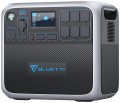Add to comparison |  |  |
|---|---|---|
| Zendure SuperBase Pro 1500 | BLUETTI PowerOak AC200P | |
from $1,299.00 | from $1,577.00 | |
| User reviews | ||
| TOP sellers | ||
4 USB-C ports. Car cigarette lighter, 3 ports DC5521, XT60 port. Jumps up to 3000 watts are allowed. UPS function. LiFePO4 battery. WiFi, 4G, GPS. | 4 USB A ports, 1 USB C port. Car cigarette lighter port DC5521. Jumps up to 4800 W are allowed. Touchscreen. LiFePo4 battery. Wireless charging power 15 W (2 fields). | |
| In box | charging station | charging station |
| Rated power | 2000 W | 2000 W |
| Peak power | 3000 W | 4800 W |
| Output waveform | sinusoid (PSW) | sinusoid (PSW) |
| UPS function | ||
Outputs | ||
| Sockets (230 V) | 4 | 2 |
| USB A | 4 pcs 5В/3A | |
| USB C | 4 pcs 5 A 100 W | 1 pcs 3 A 60 W |
| Wireless charger | 2 zones 15 W | |
| Car cigarette lighter | ||
Inputs (station charging) | ||
| From solar panels | ||
| DC input | 1 pcs DC7909 | |
| Input port XT60 | ||
Battery and charging time | ||
| Connecting an additional battery | ||
| Battery type | LiFePO4 | LiFePO4 |
| Battery capacity | 1440 W*h | 2000 W*h |
| Charging cycles | 3000 | 3500 |
| Charging time (socket) ≈ | 48 min | 300 min |
| Charging time (socket + solar panel) ≈ | 150 min | |
| Charging time (solar panel) ≈ | 144 min | 240 min |
| Charging power (socket) | 1800 W | 500 W |
| Charging power (solar panel) | 600 W | 700 W |
| Charging power (socket + solar panel) | 1400 W | |
General | ||
| Smartphone synchronization | Wi-Fi | |
| PSU | built into the body | |
| Display | ||
| Backlight | ||
| Wheels for transportation | ||
| Carrying handle | ||
| Operating temperature | 0 °C ~ +45 °C | 0 °C ~ +40 °C |
| Dimensions | 276х446х352 mm | 386x420x280 mm |
| Weight | 18.8 kg | 27.5 kg |
| Warranty | 4 years | |
| Added to E-Catalog | january 2023 | september 2022 |
Zendure SuperBase Pro 1500 and BLUETTI PowerOak AC200P are powerful charging stations with different features. The SuperBase Pro 1500 has a nominal power of 2000W and peak power of 3000W, along with 4 sockets at 230V and 6 at 100-120V, making it more versatile for connecting various devices. Meanwhile, the PowerOak AC200P offers a higher peak power of 4800W but only 2 sockets at 230V. Both devices use LiFePO4 batteries; however, the SuperBase Pro 1500 has a longer lifespan with 3000 charging cycles compared to PowerOak's 3500. The SuperBase charging time from the grid is about 48 minutes, whereas PowerOak requires about 300 minutes. SuperBase also supports solar panel charging and has additional features like Wi-Fi and GPS, which can be convenient for users seeking more advanced features. Overall, the choice between these models depends on your needs: the SuperBase Pro 1500 is better suited for multitasking, while the PowerOak AC200P is for those needing high peak power.